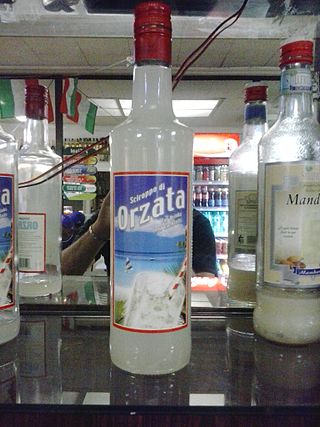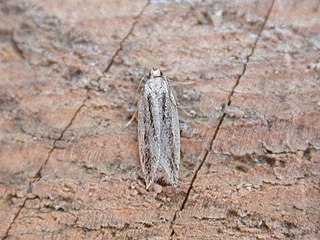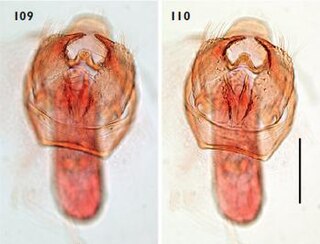
The almond is a species of small tree from the genus Prunus, cultivated worldwide for its seed, a culinary nut. Along with the peach, it is classified in the subgenus Amygdalus, distinguished from the other subgenera by corrugations on the shell (endocarp) surrounding the seed.

Amygdalin is a naturally occurring chemical compound found in many plants, most notably in the seeds (kernels) of apricots, bitter almonds, apples, peaches, cherries and plums, and in the roots of manioc.

Rosaceae, the rose family, is a medium-sized family of flowering plants that includes 4,828 known species in 91 genera.

Prunus is a genus of trees and shrubs, which includes the fruits plums, cherries, peaches, nectarines, apricots, and almonds.

Orgeat syrup is a sweet syrup made from almonds and sugar with a little rose water and/or orange flower water. It was originally made with a barley-almond blend. It has a pronounced almond taste and is used to flavor many cocktails. Orgeat syrup is an important ingredient in the Mai Tai and many Tiki drinks.

Prunus tenella, the dwarf Russian almond, is a species of deciduous shrub in the genus Prunus, native to steppes of Eastern Europe and Western Siberia, as well as dry open sites of Caucasus, Western and Central Asia.

Anarsia lineatella, the peach twig borer, is a moth of the family Gelechiidae. It is commonly found in Europe, but was introduced to California in the 1880s.
A. communis may refer to:

Ectoedemia spinosella is a moth of the family Nepticulidae. It is found in southern Europe, reaching in the north to the southern part of Great Britain, the Netherlands, central Germany and Poland. It has also been recorded from the Crimea, the Caucasus and the European part of the former Soviet Union. It is common in western Turkmenistan.

Amyelois is a monotypic snout moth genus described by Hans Georg Amsel in 1956. Its single species, Amyelois transitella, the navel orangeworm, described by Francis Walker in 1863, is endemic to the tropical Western Hemisphere, including the southern United States. Its abundance in California increased greatly during the first half of the 20th century.

Prunus scoparia is a wild almond found in Turkey, Iran, Turkmenistan and Afghanistan. It is a xerophytic shrub and it has been used as a grafting stock for domesticated almonds to provide drought resistance.

(R)-prunasin is a cyanogenic glycoside related to amygdalin. Chemically, it is the glucoside of (R)-mandelonitrile.

Prunus subg. Prunus is a subgenus of Prunus. This subgenus includes plums, apricots and bush cherries. Some species conventionally included in Prunus subg. Amygdalus are clustered with plum/apricot species according to molecular phylogenetic studies. Shi et al. (2013) has incorporated subg. Amygdalus into subg. Prunus, thereby including almonds and peaches in this subgenus. The species in this subgenus have solitary flowers or 2–3 in a fascicle.
Spurs are short, slow growing stems with greatly shortened internodes that can bear leaves, flowers and fruit. Spurs are perennial growths and commonly arise from the leaf axils on shoots.
Prunus trichamygdalus is a putative species of "wild" almond tree native to eastern Anatolia in Turkey, and nearby areas of Iran. Molecular and morphological analyses show that is very similar to Prunus dulcis, the cultivated almond, differing in its shorter petioles and smaller leaves with more numerous crenulations. Its flowers are pink, and its fruits green. Non-bitter forms may be cultivated, but its native range is restricted to elevations of 1250-2100 m on limestone slopes and gorges in the Lake Van area.

Prunus bucharica is a species of wild almond native to Tajikistan, Uzbekistan and Afghanistan, preferring to grow at 1000-1800 m above sea level. Long thought to be one of the wild species that contributed to the origin of the cultivated almond, genetic testing of both nuclear and chloroplast DNA has shown that to be untrue; the closest relative of Prunus dulcis is Prunus fenzliana.
Prunus fenzliana is a species of wild almond native to the Caucasus areas of Turkey, Armenia, Azerbaijan, Iran, and Turkmenistan, preferring to grow at 1400-3500 m above sea level. On the basis of morphology it has been long thought to be one of the wild species that contributed to the origin of the cultivated almond. Genetic testing of both nuclear and chloroplast DNA has confirmed that it is the closest relative of Prunus dulcis.

Bitter almond liqueur, is a Portuguese sweet alcoholic liquor, more specifically from the Algarve region. Clear light yellow in colour and with roughly 20% ABV, it is one of the most well-known liqueurs in its country of origin. It is made from the seeds of the bitter almond, and is similar in flavour to the Italian Amaretto.
Candidatus Phytoplasma pruni is a species of phytoplasma in the class Mollicutes, a class of bacteria distinguished by the absence of a cell wall. The specific epithet pruni means "living on Prunus", emphasizing the fact that the phytoplasma is a parasite of various Prunus species, otherwise known as stone fruits. The phytoplasma is commonly called the X-disease phytoplasma.













